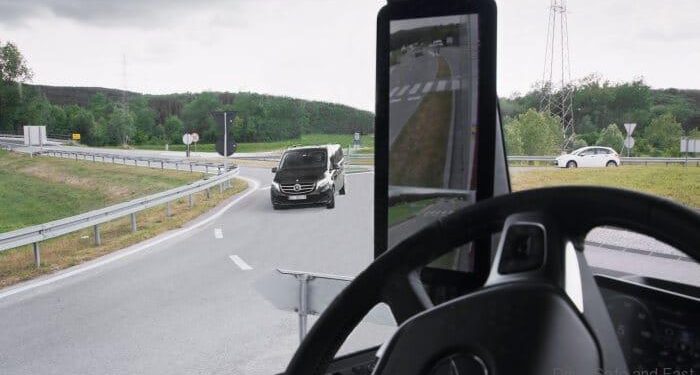Cara MirrorCam oleh Mercedes-Benz Berfungsi
Dengan teknologi bergerak selaju ianya bergerak, banyak syarikat mula memperkenalkan cermin pandang belakang digital sama ada sebagai tambahan kepada yang sebenar atau penggantian terus. Pada lori Mercedes-Benz Actros, teknologi ini dikenali sebagai MirrorCam.

Jelas sekali, sistem keselamatan yang agak mudah tetapi penting digantikan dengan sesuatu yang sangat rumit akan menimbulkan beberapa persoalan. Mercedes-Benz telah menyiarkan satu Q & A untuk menjawap beberapa pesoalan ini.
Kamera pada bingkai bumbung dan paparan di A-pillars: Actros baharu mudah dikenali pada pandangan pertama kerana cermin pandang belakang dan cermin sudut lebar yang hilang. Kelebihan sistem baru ini adalah jelas – penggunaan yang lebih rendah disebabkan oleh aerodinamik yang bertambah baik dan peningkatan keselamatan lalu lintas berkat penglihatan yang lebih baik. Tetapi bagaimana ia dikendalikan, apa yang perlu dipertimbangkan dan adakah pemandu memerlukan masa untuk membiasakan diri dengan sistem ini?
Perubahan bagi drebar?
Terima kasih kepada MirrorCam, pemandu kini mempunyai pandangan yang tidak terhalang di mana cermin belakang dan cermin sudut lebar sebelum ini meliputi kawasan besar di sebelah kanan dan kiri tiang A. Keuntungan di atas semua di persimpangan, apabila bergerak dan dalam selekoh yang ketat. Dan, pemandu tidak perlu lagi melihat ke kanan atau kiri untuk melihat lalu lintas belakang. Juga: cermin dipasang di kedudukan tetap supaya apabila mengambil selekoh pemandu mungkin kehilangan penglihatan hujung semitrailer. Sebaliknya, MirrorCam memusing imej kamera yang dipasang ke arah dalam selekoh, supaya pemandu sentiasa mempunyai hujung treler dalam pandangan. Pada dasarnya, sistem ini adalah untuk semitrailer standard, tetapi swiveling boleh dikawal secara individu. Ini berlaku pada treler moden secara automatik apabila mereka menghantar data geometri mereka ke kenderaan menunda. Pemandu boleh memindahkan jejari swivel secara manual di unit operasi pintu menggunakan butang pemilihan sampingan dan suis rocker empat hala.
Bagaimanakah MirrorCam dan Sideguard Assist berfungsi bersama?
Sideguard Assist menyokong pemandu dengan menarik perhatian mereka kepada objek bergerak dan orang bergerak di kawasan yang dipantau di sebelah kanan trak apabila terdapat risiko perlanggaran. Paparan MirrorCam menunjukkan amaran ini dalam bentuk visual. Oleh itu pemandu menerima semua maklumat yang disatukan bersama di satu tempat.

Siaran Media Mercedes
Soalan tambahan:
What are the advantages of the MirrorCam for companies?
The optimised aerodynamics can reduce consumption: the optimised wind resistance thanks to MirrorCam can result in up to 1.5 percent less fuel.
Can dirt and rain have a negative effect on the image?
Misted or dirty mirror glass and side windows have always been a problem. Thanks to the position of the cameras high up on the vehicle, the small roof above the camera lens, a special coating and the digital transmission of the image to a display in the cab, misting and dirt hardly affect the system at all. And what is particularly helpful on cold, damp days; the camera is automatically heated at temperatures below 15 degrees Celsius.
What is the advantage of the distance indicator lines on the display?
The distance indicator lines which are shown on the display of the MirrorCam system help drivers to estimate the distances behind the truck. Three fixed lines are shown together with a line that the driver can adjust precisely to mark the end of the vehicle before starting a journey. Used in combination with the information shown in the displays by the assistance systems, the driver can now better assess three typical situations in particular: when is there sufficient distance to move out to the left? When manoeuvring what is the distance at the rear of the vehicle? After overtaking, when can the driver safely merge to the right again?
Does a camera system present a disadvantage at dusk or at night?
In residual light situations, that is at dusk, the MirrorCam even has an advantage. The light transmission of the cameras is high. Thus the displays show an image that is much brighter than the natural light. So drivers receive better information about their surroundings than with a mirror. Furthermore the brightness is adjusted to the prevailing light conditions steplessly – drivers are not dazzled. All of that works both on the open road and in tunnels. If it is completely dark outside, the MirrorCam can only show the areas illuminated by the vehicle itself – just like a conventional mirror. Here, for maximum image information, the developers have selected a set-up which at present may cause a little image noise.
Can the brightness of the displays be adjusted?
Varying perception, weather conditions and times of day – there are good reasons for adjusting the brightness of displays. This is done simply via the right-hand touchscreen display or the multifunction steering wheel. If required the brightness of the right-hand and left-hand display can be adjusted differently. For this, a virtual slide controller can be accessed via the menus “Display and Brightness –> Display brightness –> MirrorCam”.
Why are the monitor images not as clear as on my smartphone?
What truck drivers are used to in the way of looking in a mirror is more decisive than the pixel density: with a screen diagonal of 15.2 inches (38.6 centimetres), the MirrorCam corresponds approximately with the previous mirror form. As before the distance and speed of a vehicle to the rear can thus be estimated using size and change in size. However: many modern smartphone displays show a pixel-per-inch ratio that is often beyond the resolution power of the user’s eye. Also the device lies in the user’s hand, so that the distance to the eye is very small. The MirrorCam displays are considerably further away and the greater the distance, the fewer details the eye can differentiate. Therefore a pixel number similar to that of a smartphone is not at all necessary for the MirrorCam.
Another point: the MirrorCam is a central safety system and therefore designed for reliability. It has successfully completed all of the specified registration procedures. As it stands today, a smartphone would fail.
Incorrectly adjusted mirrors are a potential source of danger. What is the case with the MirrorCam?
For conventional mirrors simple physics applies: “the angle of incidence equals the angle of reflection”. This means that whenever drivers change their sitting position, the area that they can see changes too. For the MirrorCam this is fundamentally different. Thanks to the camera/screen combination the driver always sees the same image – in every sitting position. The field of vision can also be set individually using the door operating unit. The advantage of MirrorCam: if drivers shift the field of vision so far that legal stipulations are no longer fulfilled, they are shown a note in the display – which is not the case with mirrors. Pressing and holding the function button quickly returns the MirrorCam to the standard setting.
How well do people who wear glasses cope with the displays and can you wear sunglasses?
Anyone wearing glasses can also easily read the MirrorCam displays. Also because there is no need to look as far to the right and left to see traffic to the rear thanks to the displays being positioned at the A-pillars. However, people wearing glasses may have difficulty getting used to the new angle of vision and distances. In this case the first question should be: are these glasses still correct for these eyes? Changes to our vision advance gradually, initially they often go unnoticed and are accepted. Any problems that people wearing glasses have with the MirrorCam are usually to do with unsuitable glasses rather than with the system. Whether you’re at your desk or behind a steering wheel – the same applies: glasses must fit the workplace! Sunglasses aren’t usually a problem either. However how much the optical impression changes, depends very much on the quality of the sunglasses. Sunglasses always have advantages and disadvantages – regardless of whether mirrors or the MirrorCam are being used.
Why do some drivers initially find it difficult to reverse in a straight line using the MirrorCam?
The MirrorCam offers two views when manoeuvring backwards: in the standard setting the large main display shows the area directly around the truck and the lower section the further surroundings. This view proves its value particularly when the driver reverses around a bend. However if the driver is reversing in a straight line, it is often better to deactivate this function. This is very simple to do – just use the button in the door operating unit. Thus manoeuvring with MirrorCam offers further possibilities in comparison to mirrors. For this very reason the system takes a little getting used to. Also the cameras are located somewhat further beyond the outer edges of the vehicle than mirrors, whereby more can be seen than with mirrors when reversing the vehicle in a straight line. This too needs time to get used to and initially glancing alternately at both displays. Because when compared with conventional mirror systems, after looking at only one of the MirrorCam displays, some drivers, when reversing, initially feel subjectively that they are driving at an angle although they are driving in a straight line.
Does MirrorCam still work when the engine is switched off?
When drivers spend their breaks in the cab, they can also activate the camera system for two minutes using a switch by the bed and on the co-driver’s side when the engine is switched off and the curtains are drawn. The area surrounding the vehicle is thus in view as well as any suspicious activity involving the truck or its load. The system starts automatically when the door is opened – so that exiting the vehicle is safe at all times.






No Comment